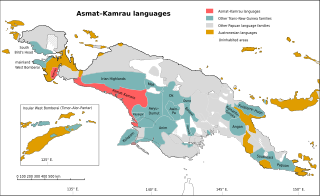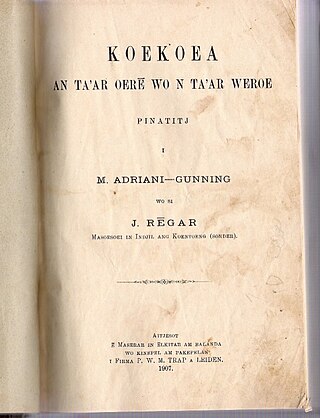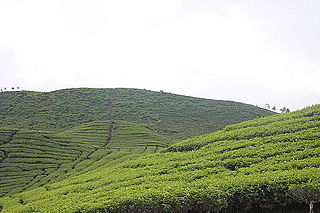
The Royal Netherlands Institute of Southeast Asian and Caribbean Studies at Leiden was founded in 1851. Its objective is the advancement of the study of the anthropology, linguistics, social sciences, and history of Southeast Asia, the Pacific Area, and the Caribbean. Special emphasis is laid on the former Dutch colonies of the Dutch East Indies, Suriname, and the Dutch West Indies. Its unique collection of books, manuscripts, prints and photographs attracts visiting scholars from all over the world. On July 1, 2014, the management of the collection was taken over by Leiden University Libraries.

Petrus Josephus Zoetmulder S.J. was a Dutch expert in the Old Javanese language. He came from Utrecht and was associated with the Society of Jesus by 1925. He worked at Leiden University in the 1930s. His first work appeared in 1930 and he continued to write into the 1990s. He lived in Yogyakarta and was interred in the Jesuit necropolis at Muntilan, Java.

Bima is a city on the eastern coast of the island of Sumbawa in central Indonesia's province West Nusa Tenggara. It is the largest city on the island of Sumbawa, with a population of 142,443 at the 2010 census and 155,140 at the 2020 census; the official estimate as at mid 2021 was 156,224. It is separate from the adjoining Regency of Bima which had a population of 520,444 according to the mid 2021 official estimates..

The Asmat – Kamrau Bay languages are a family of a dozen Trans–New Guinea languages spoken by the Asmat and related peoples in southern Western New Guinea. They are believed to be a recent expansion along the south coast, as they are all closely related, and there is little differentiation in their pronouns.
The South Halmahera languages are the branch of Austronesian languages found along the southeast coast of the island of Halmahera in the Indonesian province of North Maluku. Irarutu is spoken in the east of the Bomberai Peninsula in West Papua province.

Sundel Bolong or Sundelbolong is a 1981 Indonesian cult horror film directed by Sisworo Gautama Putra. The film is about the Javanese mythical prostitute ghost Sundel Bolong and stars Suzzanna. A sequel to the film was made in 1984, Telaga Angker. A remake titled Suzzanna: Bernapas dalam Kubur, directed by Rocky Soraya and Anggy Umbara, was released on November 15, 2018.

Pembuang River or Seruyan River is a river of Borneo, Indonesia. The river has its source near Bikit Tikung in the Schwaner Mountain Range. The eastern side of the river contains dense forest down to Sembulu (Belajau) lakes and is said to be a major habitat of the orangutan. Pembuang means "place of rejection".

The Mandarese are an ethnic group in the Indonesian province of West Sulawesi in Sulawesi. The Mandar language belongs to the Northern subgroup of the South Sulawesi languages group of the Malayo-Polynesian branch of the Austronesian language family. The closest language to Mandar is the Toraja-Sa'dan language.
Larompong is a small town and kecamatan in the southern part of the Luwu Regency of South Sulawesi, Indonesia. The town is located on the eastern coast of South Sulawesi on the Gulf of Boni, north by road from Pitumpanua. The Sampano River flows through this area and into the sea south of the town. Larompong is inhabited by the Wajo peoples who also speak a dialect of the Wajo language.
Anicet Turinay is a conservative politician from Martinique who served in the French National Assembly from 1993 to 2002.
Grand Valley Dani, or simply Dani, is one of the most populous Papuan languages in Indonesian New Guinea. The Dani people live in the Baliem Valley of the Western Highlands.

Tontemboan is an Austronesian language, of northern Sulawesi, Indonesia. It is a Minahasan language, a sub-group of the Philippine languages.
The Blambangan Kingdom was the last Javanese Hindu kingdom that flourished between the 13th and 18th centuries, based in the eastern corner of Java. The capital was at Banyuwangi. It had a long history of its own, developing contemporaneously with the largest Hindu kingdom in Java, Majapahit (1293–1527). At the time of the collapse of Majapahit in the late fifteenth century, Blambangan stood on its own as the one solitary Hindu state left in Java, controlling the larger part of Java’s Oosthoek.

Alahan Panjang is a village in the kecamatan of Lembah Gumanti, Solok, West Sumatra, Indonesia. The village is located on Kerinci Seblat National Park's eastern slopes, at an altitude of 1,400–1,600 metres (4,600–5,200 ft), near Mount Talang. Situated between Alahan Panjang and the other nearby major town of Muara Labuh are the subvillages of Air Dingin Barat, Alang Laweh, and Sungai Kalau II.

Albert Christian Kruyt was a Dutch Calvinist missionary, ethnographer and theologian. He was the first to pioneer Christianity in Central Sulawesi, notably in Poso.

Johannes Cornelis Anceaux was a Dutch linguist and anthropologist known for his extensive work on Papuan and Austronesian languages.
Piet Drabbe was a member of the Missionaries of the Sacred Heart who worked successively from 1912 to 1960 in the Philippines, the Tanimbar Islands, and on the southern coast of Dutch New Guinea, now the Indonesian province of Papua.
Frits Hermann ('Kees') van Naerssen was a scholar of Javanese epigraphy and an early figure in Asian studies in post-war Australia.
Yap Goan Ho was a Chinese Indonesian translator, businessman, bookseller, and publisher based in Batavia, Dutch East Indies. In the 1880s and 1890s, he was one of the first Chinese Indonesians to own a printing press and the first to publish Chinese language novels in Malay language translations.
Mpu Tantular was a famous Javanese poet of Javanese literature who lived in the 14th century, during the reign of king Hayam Wuruk. Tantular was a Buddhist, and was respectful to other religions. This can be seen in two items of kakawin or poetry, the Kakawin Arjunawijaya and Kakawin Sutasoma. One of the verses from the Kakawin Sutasoma was later taken as the motto or motto of the Republic of Indonesia: "Bhinneka Tunggal Ika" or different but one.











